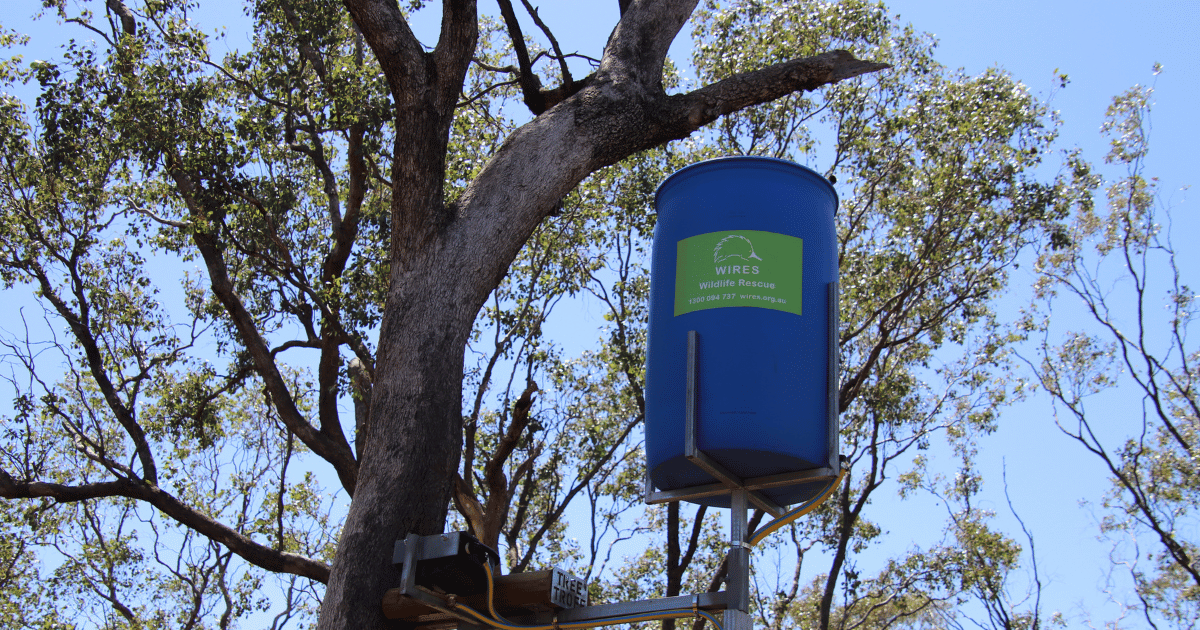WATER FOR WILDLIFE
In the wake of the catastrophic drought and fires in 2019-2020, WIRES launched the WATER FOR WILDLIFE program to provide long-term access to supplementary water for arboreal wildlife impacted by emergency events.
Take-up of the drinkers was at its highest immediately following the 2020 bushfires and slowed due to the COVID-19 pandemic and the exceptional rainfalls and floods of 2021 and 2022.
However, in September 2023, an El Niño and a positive Indian Ocean Dipole (IOD) was declared in Australia, with the Bureau of Meteorology saying that the period from September to March "could be significant in terms of heatwaves and fires".
WIRES resumed distribution of water drinkers in late 2023 and invites you, as a landholder interested in the welfare of local wildlife, to apply for a Water for Wildlife drinker. Apply Now
Eligibility Guidelines
- The applicant must be the land owner or have the authority to approve the installation and ongoing monitoring of drinkers on the land.
- Each drinker should be a minimum of 500 metres away from any other drinker/source of fresh water.
- Successful applicants will be required to sign an agreement confirming their commitment to the program.
- All applicants are expected to agree to prompt installation, supply pictures post-installation, complete ongoing long-term maintenance, and provide ongoing monitoring feedback.

Program Overview
Eight hundred drinkers are being provided free of charge to recipients in fire and drought-affected areas and areas where drinkers will support wildlife recovery or minimise risk for wildlife in future emergencies.
- Drinkers will be allocated to applicants assessed to be in priority locations where the highest benefit will be delivered for wildlife.
- Priority will be given to areas impacted by drought and fires and areas low on water. Remaining critical refuge areas will also be considered to support long-term wildlife recovery.
- The locations that will best support wild populations of arboreal species will be selected, not suburban backyards.
- The geographic spread of applicants will also be assessed as part of the program's objective to maximise impact.
- Applicants need to be willing to be engaged in the program long-term, installing and regularly maintaining the drinkers and if appropriate, be willing to relocate them to areas of higher need.
- Successful applicants will become part of an evolving national community that provides supplementary water and actively monitors drinkers to assess the program's effectiveness. This will determine the potential value to wildlife of ongoing program expansion.
- Maintenance, including cleaning and refilling water, is expected to be required every 5-8 weeks in drought conditions, less in winter or in rainy periods.
Apply Now
Why provide supplemental water?
During the Black Summer of 2019/2020, a long-term drought compounded by months of horrific fires tragically affected native wildlife. Millions of hectares of habitat were destroyed, nearly 3 billion animals were lost or displaced, and the long-term impact of these losses on biodiversity is still unclear.
According to the Bureau of Meteorology, 2019 was Australia's hottest year. The longer-term climate forecasts indicate that fire seasons will be longer and extreme weather events will continue to increase in frequency and intensity.
The Expert Panel appointed by the Federal Government assessed post-fires that 119 animal species, including the koala, were at the highest risk of potential extinction. Focusing on how best to support wild populations longer-term, WIRES began working with Dr Valentina Mella, Postdoctoral Research Associate—animal Behaviour and Conservation, School of Life and Environmental Science at The University of Sydney, in January 2020.
Dr Mella's past research found that koalas used supplemented water extensively throughout the year, even during cooler months. Time spent drinking varied with the season and depended on the days since the last rain and high temperature. The more days without rain, the more time koalas spent drinking. When the temperature was high, visits to water stations were more frequent, indicating that koalas need regular access to free water in hot weather. The arboreal drinkers were also regularly visited by other native animals, including sugar gliders, squirrel gliders, feathertail gliders, brushtail possums, tree frogs, geckos, pythons, a variety of birds, including eastern rosellas, musk lorikeets, noisy miners, galahs, cockatoos, butcher birds, kites, apostle birds and magpies.
Key partners proudly support the program, which is being delivered with the support of Robert Frend from Wildsip Pty Ltd, who designed and produced the TREE TROFF®️ drinkers.
To learn more, please review these frequently asked questions or email programs@wires.org.au.
